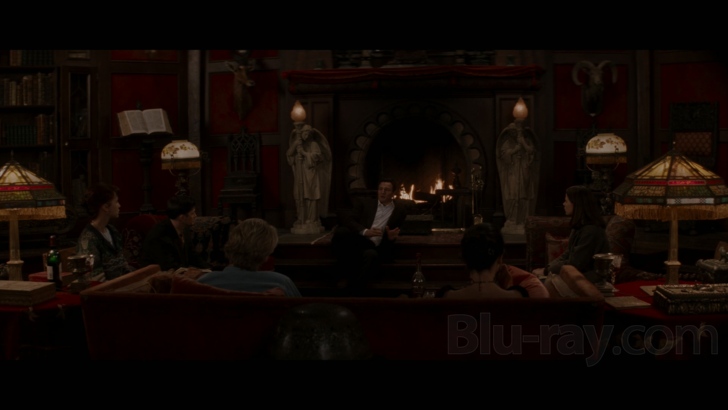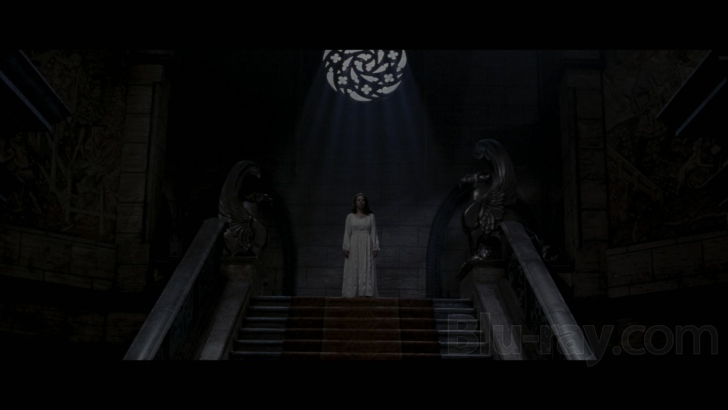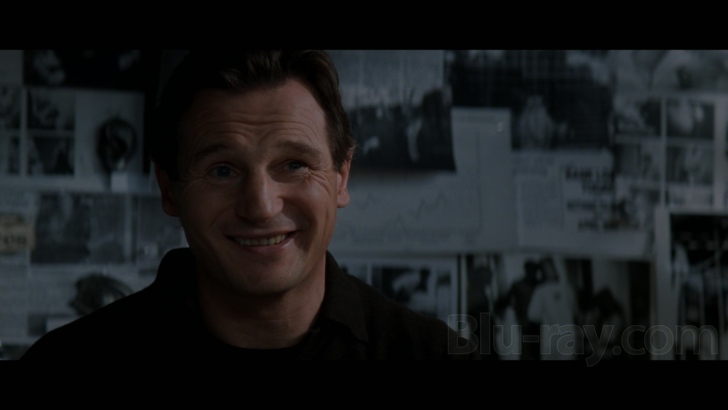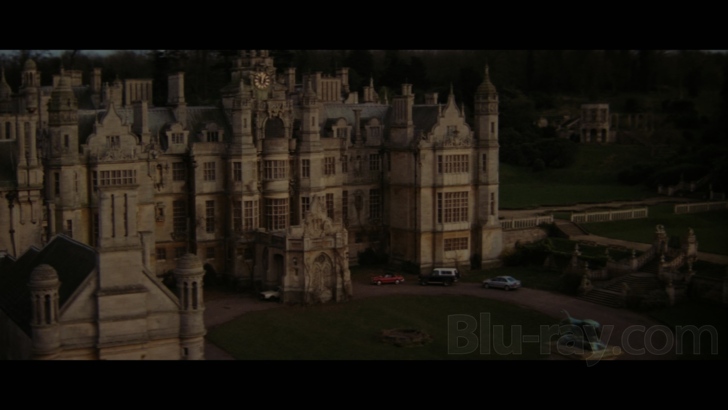The Haunting 4K Blu-ray Movie
HomeThe Haunting 4K Blu-ray Movie 
4K Ultra HD + Blu-rayShout Factory | 1999 | 113 min | Rated PG-13 | May 30, 2023
Movie rating
5.5 | / 10 |
Blu-ray rating
| Users | 4.0 | |
| Reviewer | 4.0 | |
| Overall | 4.0 |
Overview
The Haunting 4K (1999)
When Eleanor, Theo, and Luke decide to take part in a sleep study at a huge mansion they get more than they bargained for when Dr. Marrow tells them of the house's ghostly past.
Starring: Liam Neeson, Catherine Zeta-Jones, Owen Wilson, Lili Taylor, Bruce DernDirector: Jan de Bont
| Horror | 100% |
| Thriller | Insignificant |
Specifications
Video
Video codec: HEVC / H.265
Video resolution: 4K (2160p)
Aspect ratio: 2.35:1
Original aspect ratio: 2.39:1
Audio
English: DTS-HD Master Audio 5.1 (48kHz, 24-bit)
English: DTS-HD Master Audio 2.0 (48kHz, 24-bit)
Subtitles
English SDH
Discs
Blu-ray Disc
Two-disc set (2 BDs)
4K Ultra HD
Playback
Region A (locked)
Review
Rating summary
| Movie | 4.0 | |
| Video | 5.0 | |
| Audio | 4.5 | |
| Extras | 2.0 | |
| Overall | 4.0 |
The Haunting 4K Blu-ray Movie Review
Reviewed by Dr. Stephen Larson June 9, 2023The Haunting was a $91.41 million box-office sleeper from Dreamworks that I had the pleasure of seeing thrice in three different theaters during the summer of 1999. Industrial Light & Magic's outstanding visual effects work of the phantasmagorical happenings inside Hill House inspired repeat viewings. Also, the film's exploration into the history of this nineteenth-century mansion further intrigued me. After I later saw Robert Wise's The Haunting (1963), I appreciated the differences screenwriter David Self and director Jan de Bont brought to the 1999 version. Both are officially adopted from Shirley Jackson's 1959 novel, The Haunting of Hill House. Wise's scriptwriter Nelson Gidding retains the novel's subplot of the older Mrs. Sanderson as the proprietor of Hill House. Her nephew, Luke Sanderson, is both the heir to Hill House and one of the experimental subjects for the paranormal investigator's purported insomnia study. Self and de Bont drop Mrs. Sanderson from the story altogether. Luke participates in the study as a test subject who has no familial or legal connection to the house. I think the filmmakers in the '99 adaptation made this choice because they have a different family dynamic involving another participant that they wanted to probe instead. In addition, the casting of Owen Wilson as Luke suggests a character that provides some needed comic relief to both a serious plot and a frightening house full of cries and shivers. Mrs. Sanderson is part of an extended montage with voice-over narration about Hill House's history that opens Wise's picture. Self and de Bont dispense of both. They gradually peel off the layers of the house as the movie progresses. Wise's The Haunting is more of a psychological study than de Bont's. On the group commentary track included on the Warner DVD/Blu-ray, Wise recounted that Shirley Jackson would have preferred that the movie be a pure ghost story. Wise wanted to stretch the audience's imagination to the realities transpiring independent of Eleanor Lance's (Julie Harris) private thoughts and interior monologues. This film could also be regarded as a cinematic case study of hysteria. By stark contrast, the second adaptation of Jackson's book is overtly supernatural (which is perhaps what she desired that the '63 film could have been). I appreciate that de Bont and company went in an entirely different direction.

Time for an old story about Hill House.
I read David Self's "Initial Shooting Script" with a draft date of 11/10/98. At that time, it was tentatively titled The Haunting of Hill House because the producers were still securing both book and film rights. The unbilled Michael Tolkin (The Player; Deep Cover) was credited with revisions on the cover page. The 120-page screenplay contains several scenes that didn't make it into the final cut. For example, there's a fourth person recruited for Dr. Marrow's (Liam Neeson) study named David Watts who's missing from the group. Marrow and his subjects find a pair of keys to a Toyota that they believe belong to Watts, but they can't find a car parked around Hill House. Marrow receives a call on his mobile phone from Watts's roommate, who's also looking for him. Furthermore, there are additional scenes featuring either the caretaker Mr. Dudley (Bruce Dern), or his wife, Mrs. Dudley (Marian Seldes), who's essentially the housekeeper. Mr. Dudley is in the greenhouse explaining to Eleanor "Nell" Vance (Lili Taylor) and Dr. Marrow what happened to Hugh Crain's first wife. The late Marian Seldes was an excellent stage actress and I wish I could have seen more of her in The Haunting. She's older and more effective than Rosalie Crutchley, who plays the same role in Wise's movie. Seldes gives Mrs. Dudley icy and chilling qualities that remind me of Mrs. Danvers (Judith Anderson) from Selznick and Hitchcock's Rebecca (1940). The first time Nell meets Mrs. Dudley, the latter is polishing a meat cleaver.
Self's screenplay also deepens the characters' relationships. For instance, there's a little more of a lesbian undercurrent going on between Nell and Theo (Catherine Zeta-Jones) than in the finished film. Additionally, it seems that there's more going on between Marrow and Nell than just doctor and client. In the script, Nell notices that he's not wearing a wedding ring. It's implied that there's a few romantic impulses between the two. Other differences between script and film are several extended scenes that didn't make the theatrical cut. Finally, either Self or Tolkin wrote an alternate ending that was dropped from the finished version. Overall, I feel that the dialogue in the resulting film is leaner and terser than what's in the script.
The Haunting 4K Blu-ray Movie, Video Quality 

Note: Screenshots are pulled directly from the UHD disc and downsampled to 1080p. They don't encompass the full HDR so they're not representative
of the film's color values when projected at 2160p.
Scream Factory's 4K UltraHD and Blu-ray combo, which doesn't come with a slipcover, is sourced from the same 4K scan that my colleague Marty Liebman
reviewed two and a half years ago on the Paramount Presents
label. Paramount's packaging for that Blu-ray states: "Newly remastered from a 4K film transfer, supervised by director Jan de Bont." Scream's UHD
comes with Dolby Vision that's HDR10 compatible. American Cinematographer ran a long article in its August 1999 issue on DP Karl Walter
Lindenlaub's camerawork on The Haunting that I'll refer to here. The picture was shot in Panavision and anamorphic in the aspect ratio of 2.35:1.
Article writer David E. Williams documented that Lindenlaub used Kodak's Vision 500T 5279 for all the movie's interiors and Vision 200T 5274 for the
exteriors. Lindenlaub explained his lighting scheme to Williams: "My general lighting approach for the entire film was to be relatively soft on the front of
the faces, and then use backlight to give things shape and direction...Jan [de Bont] wanted between 18 and 20 setups a day, with one camera, while
constantly switching between Steadicam, cranes, normal 35mm cameras on dollies, and VistaVision [Nikon lenses] for effects work." You'll notice how dark
the movie is overall and the sparse light shown on the actors' faces throughout these screen captures. One interesting nugget from the article is that
Lindenlaub originally planned to apply a light layer of smoke to fill shadow areas and improve contrast, but since it was flu season and cast/crew were
experiencing respiratory problems, he could only incorporate a minimal amount of smoke.
Williams points out in the AC article that production designer Eugenio Zanetti's sets predominately featured brown and red hues, particularly in
the Great Hall. Those two colors are seen often on the UHD and Blu-ray. In watching both discs, the transfers are very similar. The UHD has a little more
clarity and detail. The image can occasionally look flat, especially when there are no VFX in the shots, but that was intended.
74.30 GB of space is used on the BD-100. Scream has encoded the feature at a mean video bitrate of 85.0 Mbps, with an overall bitrate of 94.3 Mbps. The
enclosed Blu-ray employs a slightly different encode than the Paramount. Scream's BD-50 averages 34.8 Mbps for the main feature. (Also, the picture
discs and menu designs are different. See Screenshot #s 23-24 for Scream's menus without the pop-up text options at the bottom.)
A dozen scene selections accompany the 113-minute film.
The Haunting 4K Blu-ray Movie, Audio Quality 

Scream has supplied a DTS-HD Master Audio 5.1 Surround (4225 kbps, 24-bit) and a DTS-HD Master Audio 2.0 Stereo downmix (2017 kbps, 24-bit). I
listened to both but will focus primarily on the 5.1 mix. When played at normal listening levels, I found the dialogue to generally reside on a register that's
lower than more contemporary films. For regular daylight scenes, I found myself turning volume up a little louder to discern all the words. A big reason
that The Haunting is such a sonically active experience is the incredible work turned in by sound designer and re-recording mixer Gary Rydstrom.
The latter revealed to San Francisco Chronicle columnist Edward Guthmann in a interview published while The Haunting was in theaters
that he compiled 532 sounds for the film, recording most of them himself! An anonymous interviewer at FilmSound.org also spoke to Rydstrom in '99
about his sound sources. Rydstrom said he got Hill House's creaky doors from the cellar door of a Northern California winery he visited and recorded. The
sounds of wind and children emanated from an old hotel near Glacier National Park in Montana where he was stranded with his wife years earlier.
Rydstrom said he spent three days recording gusting winds through the cracks of windows and doors.
Rydstrom described a "breathy exhale" in an unpublished interview with Dr. William Whittington (a professor at USC's Cinema and Media Studies who
specializes in film sound) when Nell first opens the main door to Hill House. That was the same sound effect that I remember hearing not only in that
scene, but when there's a fade-in to Hill House at the beginning. Rydstrom additionally described a wood-creaking motif in Nell's bedroom. He told
Whittington that he combined real wood creaks with the sounds of apes, gorillas, and other mammal "growls."
Inasmuch that I would have loved a new Dolby Atmos mix, the DTS-HD MA 5.1 delivers a wide dispersal of Rydstrom's sound mix. When there's pounding
on Nell's bedroom door, it felt like someone was poking through my wall. The wind, shrieks, and whispers are nicely distributed across the rear speakers.
Ever since I first saw The Haunting, I always though that the full sound track was a perfect marriage between Rydstrom's design and Jerry
Goldsmith's music. Indeed, some of the atmospheric notes Goldsmith wrote are seamlessly blended in with Rydstrom's audio effects that they're
practically indistinguishable. Goldsmith's cue "A Place for Everything" is his theme for Nell played on flute. She hums it three times in the film. It's a
lullaby that reminds me of "Carol Anne's Theme" from Poltergeist (1982). The source cue "The Carousel" is a circus tune that Goldsmith weaves
into the film for two scenes. The masterful "Finally Home" features the most dramatic music from the score and is the perfect accompaniment for the
climax.
The Haunting's theatrical mix contained the then-new Dolby Digital Surround EX. Dreamworks issued a separate DVD with a DTS-ES 6.1 mix that
adds a rear center channel. That mix hasn't been ported over to this release.
Paramount's Dolby TrueHD Audio 5.1 Surround mix averages 4380 kbps, while the DTS-HD Master Audio 5.1 Surround on Umbrella Entertainment's
Australian Blu-ray averages 4220 kbps.
Scream's optional English SDH deliver a mostly accurate transcription of the dialogue. There are some errors, though. For example, at the end of a
sentence, Eleanor's sister says "Nell" instead of the subtitled "now."
The Haunting 4K Blu-ray Movie, Special Features and Extras 

Shout!'s extras duplicate the Paramount Presents Blu-ray. Absent from both are the complete Production Notes that appear on the text screens of
Dreamworks' DTS DVD and the standard edition.
Note: I pre-ordered The Haunting on Amazon in autumn, 1999 and vaguely recall (as a DVD reviewer pointed out in November of that year) a
sticker on the case stating "never before seen footage!" Years ago while I was browsing the text-based extras, I came upon an easter egg with a
screenshot titled "Deleted Scenes." There were a handful of omitted scenes listed but I remember that I couldn't click on any of them. One promised to
reveal an update about Dr. Marrow's assistant, Mary Lambetta (Alix Koromzay), whose eye was injured in a supposed accident at Hill House. A scene
updating Marrow on Lambetta's status doesn't appear anywhere in the shooting script I read. It seems that de Bont filmed additional scenes and
Dreamworks was planning on including them on DVD but for reasons still unknown, the studio never did.
- Filmmaker Focus: Director Jan de Bont on The Haunting (9:14, 1080p) [2020] - de Bont discusses working with Steven Spielberg, his acting principals, the sets of The Haunting, how his crew achieved some of the effects, and his overall impressions of the film more than twenty years later. In English, not subtitled.
- Behind-the-Scenes Featurette (27:12, 480i) [1999] - this archival program hosted by Catherine Zeta-Jones originally appeared on the 1999 DVDs. It mixes talking heads with clips from The Haunting (as well as other films) and B-roll footage. Interviewed are producer Susan Arnold, director Jan de Bont, producer Donna Arkoff Roth, producer Colin Wilson, executive producer Samuel Arkoff, Dr. Robert Stepsis (Principal, Harlaxton College), Nick Hughes (Manager, Angel and Royal Hotel), British actor Roy Dotrice, production designer Eugenio Zanetti, speicial effects coordinator John Frazier, visual effects supervisor Phil Tippett, Craig Hayes (also a visual effects supervisor), sound designer Gary Rydstrom as well as actors Liam Neeson, Lili Taylor, and Owen Wilson. In English, not subtitled.
- Teaser Trailer (1:16, 480i) - the shorter of the two trailers is displayed in in 2.35:1 anamorphic widescreen and comes with Dolby Digital 5.1 Surround (448 kbps).
- Theatrical Trailer (2:23, 1080p) - Dreamworks' original trailer for The Haunting presented in 2.35:1 anamorphic widescreen and accompanied by Dolby Digital 5.1 Surround (448 kbps).
The Haunting 4K Blu-ray Movie, Overall Score and Recommendation 

The Haunting (1999) remains an underrated haunted house thriller that is very different from its predecessor: Robert Wise's eponymous 1963 classic, which is more psychologically oriented. It should be specified that de Bont's film is not a remake of the earlier version of Jackson's novel. It's great that Scream Factory has brought it to 4K UltraHD with the same master used about three years earlier for the Paramount Blu-ray. I would have loved for Scream to record new interviews with the cast and/or filmmakers. Extras are recycled from past home video editions. There are no new supplements. Still, A VERY SOLID RECOMMENDATION. If you already own the Paramount Presents edition, I would wait till this set drops to around $22.
Similar titles
Similar titles you might also like

The Boy
2016

Greystone Park
2012

1408
2007

Mama
2013

Winchester
2018

The Disappointments Room
2015

Crazy Eights
2006

Shock
Schock / Beyond the Door II
1977

Marrowbone
The Secret of Marrowbone
2017

Last Shift
2014

The Awakening
2011

Deadline
2009

Thirteen Ghosts
Collector's Edition
2001

The Legend of Hell House
1973

House on Haunted Hill
Collector's Edition
1999

Paranormal Activity: The Marked Ones
2014

Return to House on Haunted Hill
Unrated
2007

Poltergeist II: The Other Side
1986

Poltergeist 3D
Extended Cut
2015

The Turning
2020


